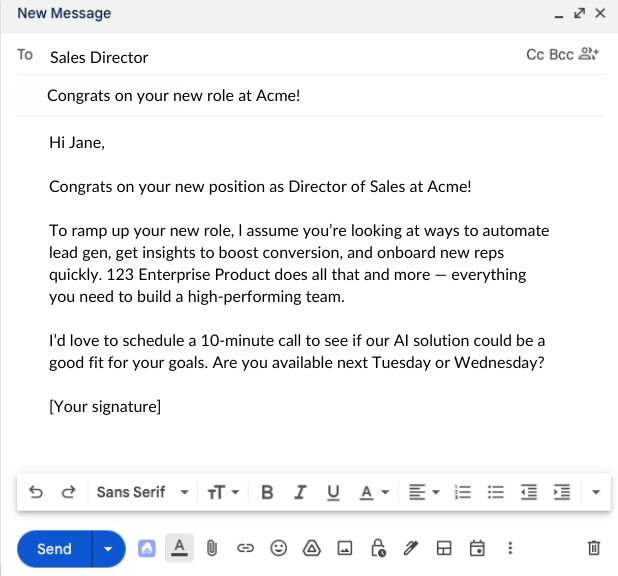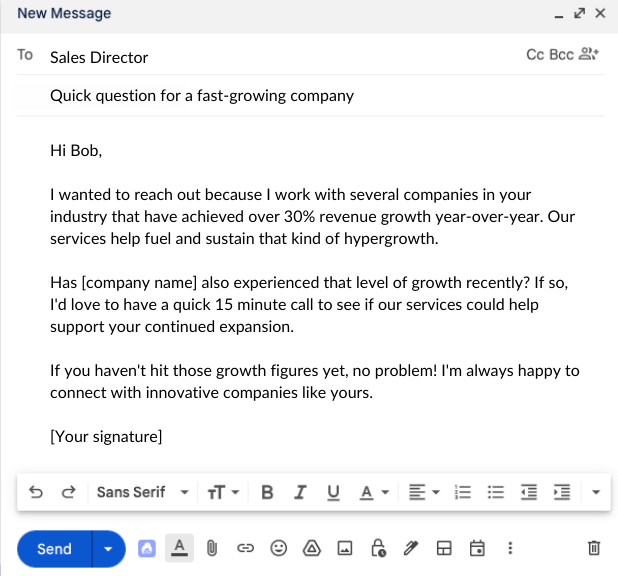Emails are surprisingly effective in the B2B world, including for prospecting. But you can’t just copy and paste a cookie-cutter message into every prospecting email you send if you want to close deals. Creating emails that are interesting and convert demands a mix of solid strategy and persuasive personalization. So liven up your inbox with […]
Emails are surprisingly effective in the B2B world, including for prospecting. But you can’t just copy and paste a cookie-cutter message into every prospecting email you send if you want to close deals. Creating emails that are interesting and convert demands a mix of solid strategy and persuasive personalization. So liven up your inbox with these tried and true email prospecting rules.
What is email prospecting?
First, a quick reminder: sales prospecting describes the activities that the sales department does to gain new potential customers. A prospect is a person or company that has not engaged with your marketing assets or sales team, but, because they fit certain criteria and/or show certain intent signals, they are qualified for sales outreach. In simpler terms, a prospect has most likely never heard of your company, but you’ve got an awesome sales intelligence platform that tells you that they look like potential customers, so you go ahead and contact them.
(This is as opposed to a lead, who has interacted in some way with your brand and so any sales pitch does not have to start from scratch.)
Next, let’s talk about email. B2B email has a higher ROI than search, content marketing, and social media. Similarly, email marketing has an average click-through rate of 2.62%, compared to 2.00% for Twitter (or “X”), 0.94% for Instagram, and 0.72% for Facebook.
Put prospecting and email together, and you get a proven method for reaching out to cold contacts. Essentially, a prospecting email allows a salesperson to introduce themselves and explain how they can bring value to the reader. The goal of the email is usually to arrange a phone call or video meeting to build a personal connection and provide more details about the value proposition. Prospecting emails can also come from the marketing department, where they are meant to encourage some form of engagement such as downloading content or receiving a newsletter.
The advantages of cold email
The other essential outreach method is cold calling, which is an art and science with its own set of rules and benefits. But with email, you’re looking at a bunch of advantages, including:
- The ability to send emails to a large number of prospects simultaneously
- Targeted outreach through segmenting email lists based on different criteria
- A high degree of automation
- Ease of analytics, tracking, and A/B testing
The key to success in email prospecting is personalization. That means customizing things like name, pain points, and content click-throughs, which can significantly improve response rates.
Speaking of which, whenever a prospect engages with the call-to-action of an email, it sometimes takes them to one of your marketing assets. At that point, they are encouraged to proceed further along the funnel. This is a significant benefit as it can move them from essentially no knowledge of your product to at least some kind of brand awareness. Another CTA for cold emails is to set up a phone call for further conversation.
The fundamental elements of an effective prospecting email
Reaping these benefits won’t just happen. Over the years, sales and marketing professionals have created a set of best practices that improve open, engagement, and (ultimately) closing rates. Here are some of the highlights to get you there:
Short subject line
Studies on subject line length indicate that 6-10 words leads to the highest opening rates. Other tips for creating a compelling subject line are to convey a sense of urgency and (if possible) to include the prospect’s name.
Personalized opening line
Another good place to insert a name is in the email’s opening line. But, instead of writing “Hi X, my name is Y, how are you?”, it’s better to grab the prospect’s attention with something that explains why they should keep reading. This is based on the principle of “what’s in it for me?”. Examples include:
- Can I share a quick idea with you that’s helped [other clients/customers] [result you helped achieve]?
- Are you interested in [the result your company provides]?
- Companies in your industry are adopting this solution – here’s how it’s helping them
Body content focused on the prospect’s goals
The rest of the email body should expand upon this theme. According to research by Boomerang, the total length of the email should be between 50 and 125 words, so squeezing your message into that space might be a challenge. With the optimal word count being so small, you should make your message super-focused and have a single, specific goal in mind. One of the tricks for optimizing your email pitch is to use a copywriting formula like AIDA (Attention, Interest, Desire, Action); PAS (Problem, Agitate, Solution); or the 4 Cs (Clear, Concise, Compelling, Credible).
Call-to-action (CTA)
The goal of the email is to encourage the prospect to click-through via the CTA. Because the CTA itself is only a few words, you might explain the purpose of the CTA in the main text of the email. In addition, the CTA should clearly state what happens when the reader clicks – do they receive content, sign up for a newsletter, or book a meeting? So, if the CTA leads to booking a sales call, you could preface it by stating “click below to set up a call with me,” while the CTA itself says something to the effect of “Book a Call”.
Signature
Signatures that include the contact information for a real person in your organization serves at least two purposes. It imparts a sense of authenticity (i.e., “less spamminess”) and gives a practical way for the prospect to talk to someone if they have questions.
The best prospecting email templates
The most successful emails are those that trigger interest from the prospect, and that means making the subject of the email something relatable instead of sending an email that just seems like another “out of the blue” sales pitch. Here are a few examples of templates that describe effective ways to connect with a prospect.
Following a prospect company announcement or action
A great way to illustrate this point is to send an email that uses an opportunity to warm up the communication, such as:
- An announcement released by the prospect company about (for instance) having closed a major deal
- A prospect moving to a new company (detectable through a job change filter)
- The prospect’s organization purchasing a new technology (detectable through a technology filter)
- A response to a social media post (providing a compliment or piece of advice)

Making your own opportunities
If the prospect hasn’t made any noticeable moves recently, there are still ways to craft a relevant message. For example:
- Provide advice to the prospect based on a challenge that is common to a person with their role
- Ask them about how they are addressing their pain points, and then send a response explaining that they are missing a vital solution (yours!)
- Mention that you’ve got a new feature built expressly for a product like theirs

The reverse prospecting email template
Yet another email outreach method is to use the concept of “reverse prospecting”. The basic idea here is for the prospect to reach out to you, thanks to an email that provokes a response. These opening lines provide examples of how this might be done:
- Our solution is for someone looking at advanced applications. Do you believe you fit into this category?
- We’re looking to partner with companies that are showing X% yearly growth. Do you qualify?
- We’ve received a great response from very competitive firms, does this describe you?

Common mistakes in prospect emails
It’s pretty clear that some do’s, like personalization, length, and style are critical in prospecting emails. But the don’ts are equally as important:
- Don’t press “send” until you’ve thoroughly proofread the email. Even if ChatGPT takes over the world someday soon, it’s still possible for your mistakes to make it past the grammar check.
- Don’t be sales-pushy. Business people get sales emails all day long and they learn to ignore them. Instead, aim your text at building a connection between you and the prospect as a way to make their jobs easier.
- Don’t forget about the follow-up. There will actually be some prospects out there who did not notice your email or who haven’t found the time to read it. Checking whether a prospect received your email can make you seem more professional and gives you an added chance for a conversation.
A/B testing prospecting emails
For something with a recommended maximum of 125 words, there sure are a lot of rules for prospecting emails. How do you know that you’re doing it properly?
Emailing gives you many chances to experiment through A/B testing. By varying the style of writing, core messaging, templates, and even what type of prospects you contact, it’s possible over time to arrive at a winning combo. For example, you can create two subject lines and see which gets the better response, and then try two versions of the opening line, and so on.
Tools and software for email prospecting
When it gets down to email prospecting basics, you should start at the beginning by identifying high-potential contacts. That’s something you can do pretty easily with Lusha, where you can use our prospecting platform or extension to find contacts that fit their ICP.
And of course, you can’t send an email to a prospect without, you know, their email address. There are a lot of email prospecting tools like Apollo, Cognism, ZoomInfo, and UpLead that can help you find prospects’ emails. But Lusha can help you with that too.
Plus, with our enrichment data, you can enhance data you already have to get the information you need to craft an on-point, customized message. Even better, you can prospect and email all in the same place thanks to Lusha Engage, our free email sequencing tool.
Lusha’s award-winning business intelligence platform is the answer to all of these challenges since it enables personalized prospecting at scale, allowing your team to increase engagement rates with high-quality contact data.
Key takeaways
- Email prospecting is a method of outreach where a salesperson introduces themselves, their relevance to the contact, and their value proposition.
- For email prospecting success, pay attention to both the format and the message of your email, which should be personalized, short, capture the interest of the reader, and provide a means for engagement through a CTA.
- One tool that can increase your open rates is a set of email templates that give you an attractive “opener” and a structure for writing an effective message.



